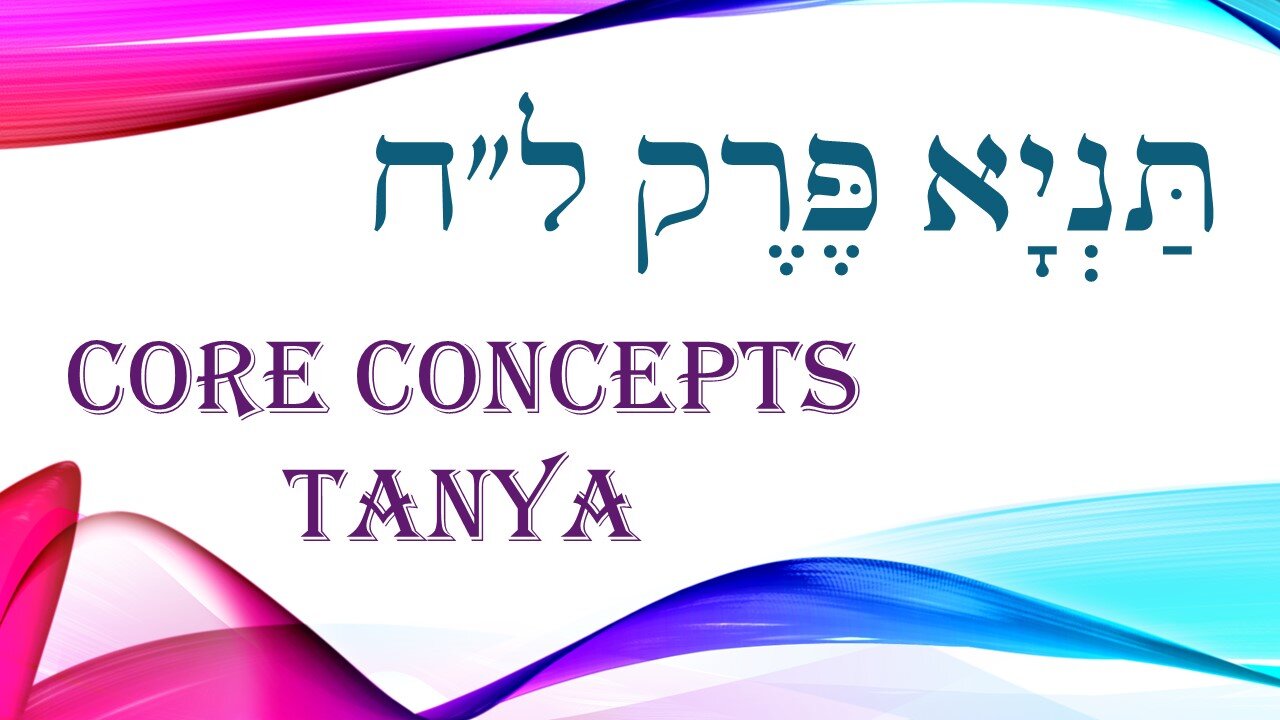Premium Only Content

Core Concepts Tanya: Chapter 37
Brief recap of Chapter 38:
1. Chapter 38 is the first of three chapters addressing the question, "why is thought without speech not as acceptable as speech without thought?" As in, why does an action done by rote "count" more than a deep appreciation of a mitzvah not done at all?
As the past few chapters emphasized, it’s all about action. Thought doesn't actually change the physical world, action/speech does.
2. Is all action the same? What about kavana, the concentration, focus, motivating intention (i.e. desire to connect to Hashem and His will) of the mitzvot we do?
Even we can tell the difference between someone who trudges through Judaism and the one who embraces every mitzvah with excitement, for whom Judaism is much more alive.
How does that factor into our fulfillment of the mitzvot beyond this world?
3. "A mitzvah without kavana is like a body without a soul."
Both body and soul are created by G-d, yet, the soul animates a body and gives it life.
If both body and soul have a Divine life force, then why is one physical and one spiritual?
4. Several steps had to be undertaken in creation so this world could handle G-d’s light without dissolving into nothingness. "Descend from level to level" through the spiritual worlds, the idea of creation until this world believes it exists as a separate entity.
“Contraction" lessens the dosage, because the "farther" from the source, the less amount of light it can handle. Then, even greater "contractions" to enable the leap from spiritual to physical, enough for G-d to "hide" in this physical world. The life-force is clothed in kelipat nogah, which contains the potential for holiness or lowering to the "other side," depending on how we use it.
5. Contraction is like a partially boarded up window, the light that comes through is the exact same intense as outside, so the quality is the same, it's just restricted.
Concealment is when curtains are placed over a window to lessen the strength of intensity, so it's a dimmer, lesser quality light coming through. Kelipa acts as a "veil" over the Divine light, hiding it equally from all of creation so G-dliness is not apparent in this world.
6. The above is evident in the four categories of creation: Mineral, Vegetable, Animal, Man.
A Divine life force brought each into existence, yet, the higher up the "food chain" the more life and growth we see. The differences are because the Divine light is way more contracted in a rock than in man. Taking this even further, it's even less contracted in the soul, which is why it's a spiritual being.
7. Connecting this idea with the mitzvah and kavanah, the mizvah is like the initially contracted Divine light. Because, when a mitzvah is done automatically, it's not obvious that it's being done to unite with G-d's will. Kavanah brings about a greater revelation of the Divine light.
A mitzvah creates a home for Hashem in this world; kavanah turns on the lights.
8. Mitzvah, the body, has two levels:
(A) Mitzvot done through physical action. (Mineral)
(B) Mitzvot done through thought and speech, prayer/Torah study, which is considered more refined. (Vegetable)
Kavanah also has two levels:
(A) Instinctual/natural kavana (Animal)
(B) Intellectual kavana (Man)
9. Intellectual Kavanah is a higher level like the category of Man, as it stems from intellectual contemplation and free choice. This allows the person to experience mitzvot on a higher level, because of the love or fear or awe animating the mitzvah. The love/fear comes from a greater understanding and appreciation for the mitzvot, as it creates a palpable love and fear within a person.
10. What about someone who isn't feeling these emotions because he has limited understanding of such things? What motivates him? This person must tap into the "hidden love" inherited from our forefathers and bring it into conscious thought, so even if he can't feel, he can still bring it to mind and use that as motivation to fulfill His will. That's why the lower level of kavana is compared to the Animal category, as it's motivated by an instinctive, innate love and fear of Him.
11. Kavana is like the wings of a bird, which allow it to fly. The greater kavana we have in fulfilling a mitzvah the higher that mitzvah will rise in the spiritual worlds.
Going back to the beginning, we can see the difference between someone who fulfills Torah and Mitzvot with excitement as compared to someone who simply gets the mitzvah done.
Both get credit for doing the mitzvah, but the person who fulfills Torah/mitzvot with feeling is someone whose Torah and mitzvot are more alive, someone who's joy, awe, or fear are a testament to his desire to connect with G-d. This isn't only evident to us in the physical world, but true in the spiritual worlds as well, showing how impactful is the effect of every mitzvah that we do.
-
 LIVE
LIVE
SpartakusLIVE
7 hours agoRule #1 - The BEST Loot is ALWAYS in the OTHER GUY'S BAG
602 watching -
 2:16:27
2:16:27
ThatStarWarsGirl
4 hours agoTSWG LIVE: CHRISTMAS IS COMING! Stargate's BACK & DC is Doomed?!
16.9K3 -

I_Came_With_Fire_Podcast
12 hours agoDid Pete Hegseth Commit WAR CRIMES | No more INCOME TAX | More Fraud in Minnesota W/ Mike Caldarisie
20K9 -
 1:32:30
1:32:30
Adam Does Movies
7 hours ago $0.55 earnedTalking Movies + Ask Me Anything - LIVE
16.5K1 -
 2:12:14
2:12:14
TheSaltyCracker
5 hours agoWar Crimes ReeEEStream 12-03-25
72.1K145 -
 1:31:59
1:31:59
Glenn Greenwald
6 hours agoTrump Administration Claims to Save Hundreds of Millions of Lives by Blowing Up Drug Boats; Ethan Klein's Unhinged Vengeance & Lawsuits Against Other YouTubers: With Taylor Lorenz | SYSTEM UPDATE #553
104K133 -
 19:14
19:14
MetatronCore
21 hours agoHow Propaganda works on your Brain
16.4K6 -
 1:26:32
1:26:32
Joker Effect
3 hours agoWHO IS TYSON HOCKLEY?! What does the IRL streaming space look like? WHY IS EVERYONE SUEING EACHOTHER
7.37K -
 2:48:40
2:48:40
Barry Cunningham
6 hours agoLIVE BREAKING NEWS: Erika Kirk and TPUSA Have Had It With Candace Owens | Where Are The Children?
54.7K67 -
 15:30
15:30
IsaacButterfield
20 hours ago $0.99 earnedViolent Immigrant Crime Is Exploding in Australia
12.5K17